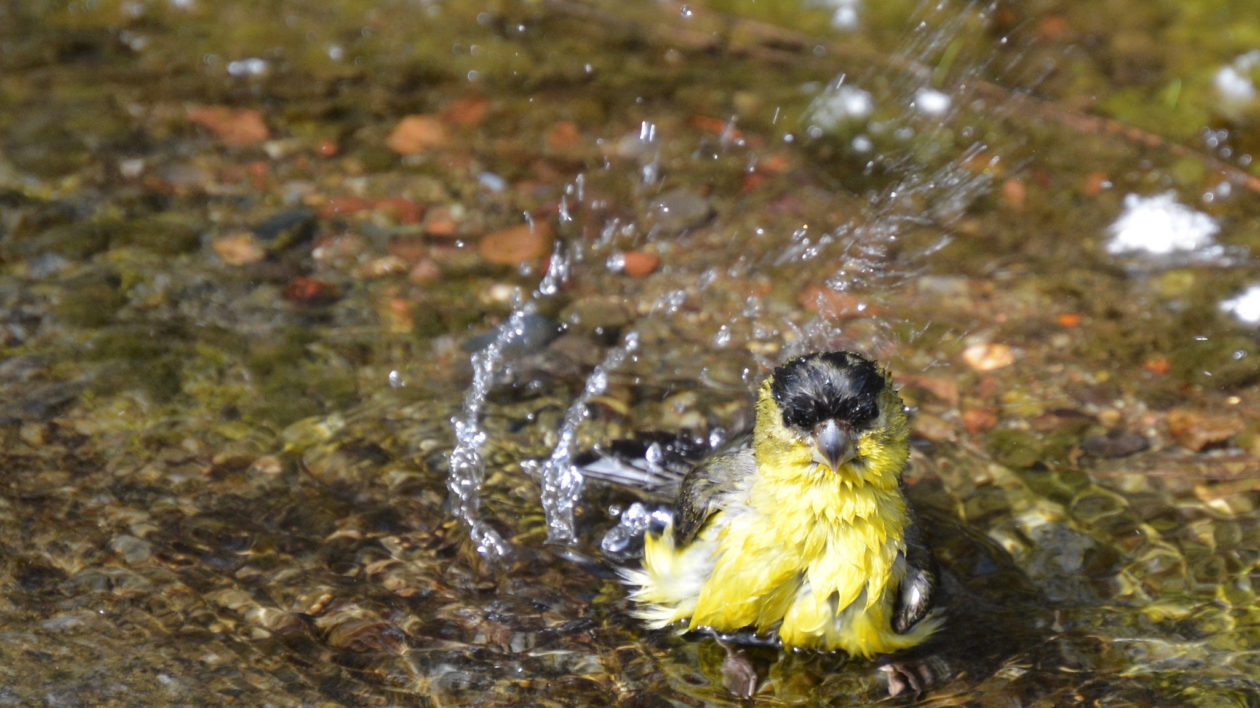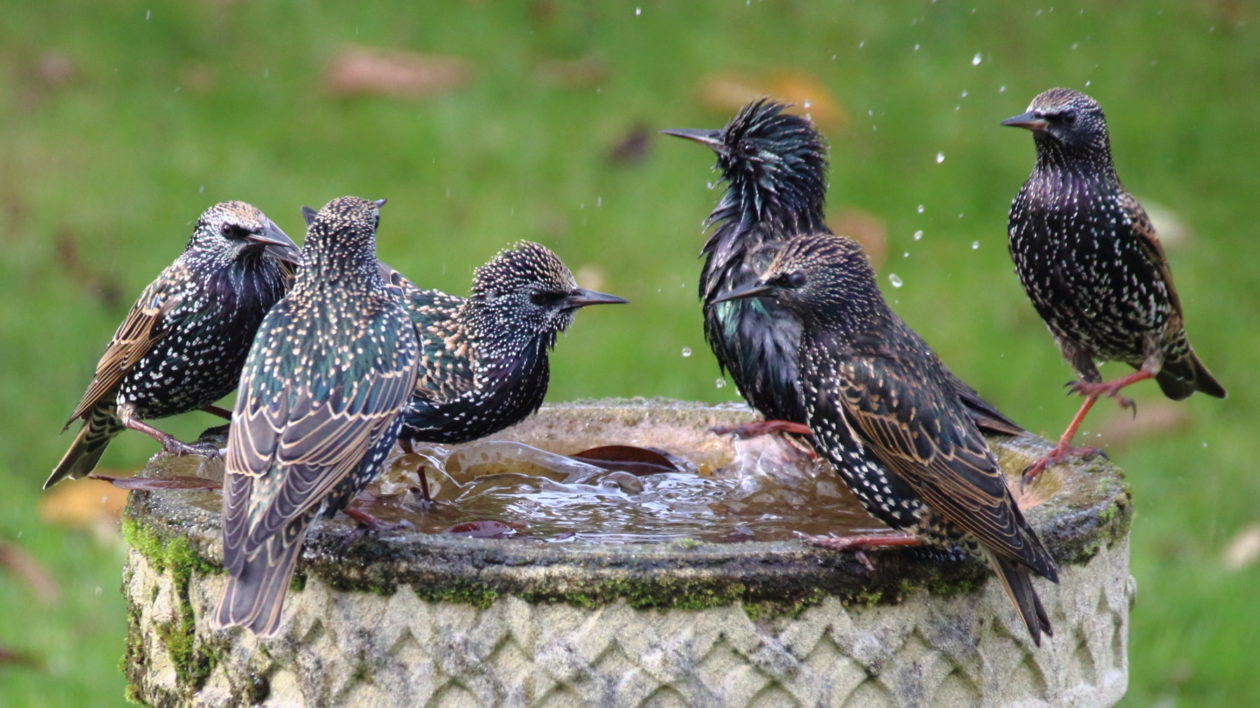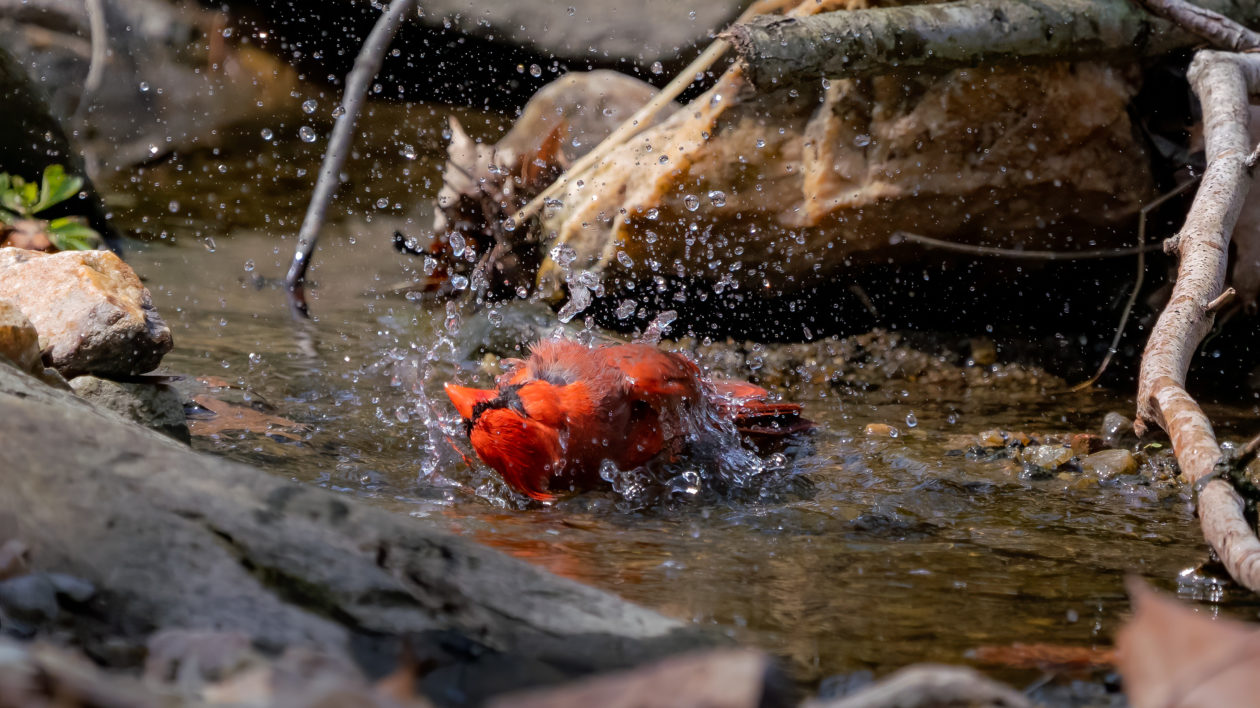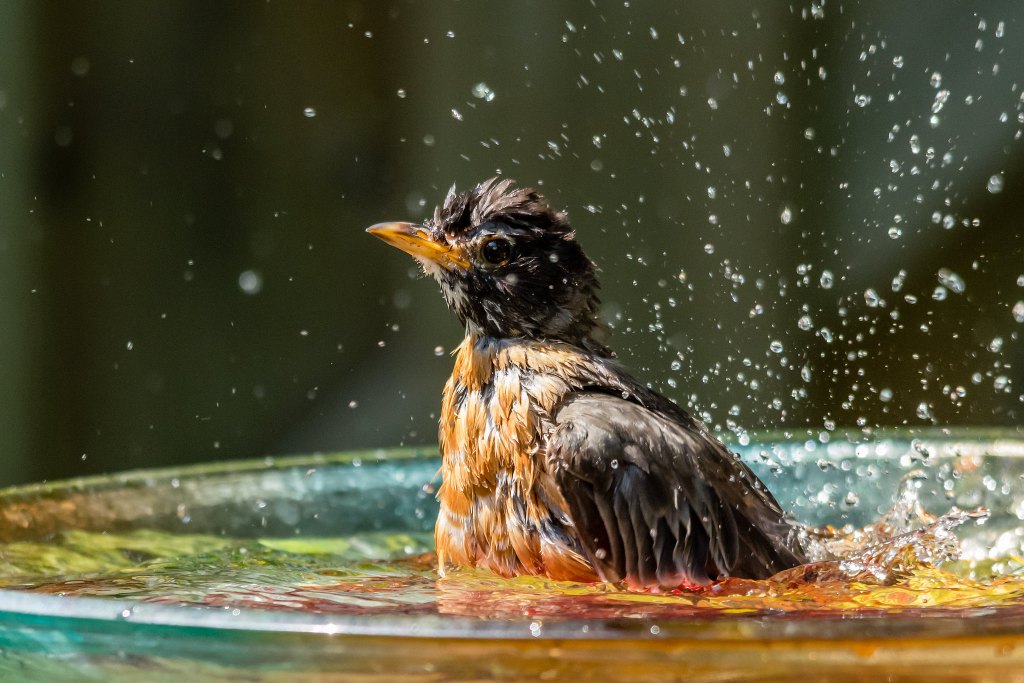What does science tell us about the importance of a good bath to a bird?
The answer: surprisingly little!
A study published in 2009 stated it plainly: “Birds of most species regularly bathe in water, but the function of this behavior is unknown” 1.
This post is about the cool green science of bird baths: what we know and intriguing areas of inquiry for future research.
Rub-a-Dub-Dub, Many Birds in the Tub
Despite the lack of knowledge about the function and importance of baths to birds, we all know that birds (like the rest of us) love having water around for bathing and drinking.
When working with migrant birds in the Yucatan Peninsula, I first began to understand how seriously birds take the business of bathing. We were studying warblers that were typically territorial. These birds frequently engaged in threat postures and even in fights to enforce the boundaries between their exclusive home ranges at our mangrove study sites.
But at a communal bird bath, there was a nightly truce.

Each evening at dusk, in a special spot in the mangroves where a freshwater spring bubbled up from the ground, numerous American redstarts, northern parulas, magnolia warblers, common yellowthroats and yellow warblers took turns bathing.
One by one, they shared this little oasis before going to roost for the night.
Seeing territorial warblers calmly taking turns for a bath tells us that for a bird, having access to water for bathing is worth checking one’s combative tendencies—at least for a few minutes.

Why Birds Take Baths
So, what’s so important about a bath?
The number of relevant scientific articles can be counted on one hand. There are very basic descriptions of the mechanics of bird bathing in North American2 and Australian birds3, an experimental examination of wetting and drying of disembodied feathers4, and a recent pair of studies that experimentally deprived captive starlings of bath water 5,1.
Although the functions of bird bathing aren’t clearly known at this point, these studies suggest that bathing plays an important role in feather maintenance.
Feathers are a bird’s lifeline: they insulate, waterproof and, of course, provide the power of flight.
Feathers get replaced once or twice a year. In the interim, they need to be kept in good condition. The sun, feather-munching mites, bacteria and gradual wear take a toll on feathers. A set of year-old flight feathers look like they’ve been through the ringer: they are frayed and dull.

A good bath may keep those precious feathers in the best condition possible for as long as possible.
Two recent studies on captive starlings have progressed our understanding a bit further. In one paper, Brilot and colleagues hypothesized that depriving a bird of a bath would result in more disheveled feathers and translate into poorer flight performance.
They tested a group of freshly-bathed starlings and a group that had been deprived of a bath for three hours prior to the experiment. The starlings deprived of a bath were clumsier when flying through an obstacle course made of vertically-hung strings, bumping into more strings as they flew.
In their second paper on starlings, the research team examined whether the bath-deprived starlings knew they were clumsier. They did this by presenting bathed and unbathed groups of birds with recordings of starling predator alarm calls – and delicious meal worms – at the same time.
The experiment indicated that birds with access to bath water were more willing to let their guard down and feed, despite the recorded call signaling the presence of a predator. The authors suggest that the unbathed birds were more cautious because they were aware that their ability to escape was impaired.
This work tells us that, beyond preserving feathers over the long term, bathing even makes a bird a more agile flier and more adept at escaping predators in the short term.
These studies are helpful, but the function of bathing still eludes us.
How does it make these birds better fliers? Does it help realign the tiny barbs that hold feathers together? Does it help distribute protective oils? Does it improve feather performance in some other way?
This all leaves me wondering about those birds in the Yucatan. Our research was focused on revealing differences in habitat quality among individuals, mainly by measuring the food resources of the birds. We reasoned that more food equaled birds in better condition with a better chance of survival.
But maybe we were ignoring another important aspect of habitat quality – access to bathing water. We see from the starling work that being deprived of a bath could make an unbathed bird easier to catch, so baths might play a role in survival too.
Until we get an answer from science, we will need to rely on common sense and keep those backyard bird baths full.

Preparing Your Backyard Bird Bath
Many of us with bird feeders also have a bird bath to go along with it. Even in the coldest months of the year, I’ve found that birds are eager to take baths.
I recently poured a warm tea kettle of water into my frozen bird bath and there was an instant scrum as the cardinals and white-throated sparrows jockeyed for position around the bath.
A more sophisticated approach to maintaining a bird bath in winter is to use a bird bath heater.
When warmer times come around, a water mister can enhance the backyard bird bathing experience.
Misters keep water fresh and brings a lot more attention to the bird bath. They are a great bird attractor during the spring and summer when people typically aren’t feeding birds.
Although it would be nice to know the exact functions of bird bathing, a lack of scientific knowledge won’t ever get in the way of a good bath.




I;ve collection of videos taken from my house. ‘LET THE BIRDS COME TO YOUR HOUSE” is the title of my project. I ‘ ve to make a documentary on the subject “birds bath’ I think your valuable contribution if any as literature on the subject specified .. Sir?
A flock of finches just used our bird baths. How do birds know where they are? It seems like they tell each other because we get more and more. Titmouses, chickadees, cardinals, blue birds, bluejays, Carolina wrens, and more.
I have several bird baths of varying sizes and depths in strategic spots in my yard, and different birds favor different baths. I love watching them bathe, and the pitter patter of their splashing never fails to make me grin. I always thought there were several reasons for bathing:
1. Get clean.
2. Cool off.
3. Dislodge some parasites.
4. Have fun. (They sure look like they’re having fun, especially the robins.)
I agree with other commenters that changing the water in the bath daily keeps mosquitoes out of the equation. It’s also better for the birds. They do seem to enjoy the water more when it’s clean.
Baths do wonders for feather quality. My wife’s parrot becomes more and more disheveled, the longer it’s been since his latest bath. Flight feathers (wing and tail) fare the worst. A bath restores the feathers almost completely.
I would assume that another reason for bathing has to do with nesting. Birds can regulate the amount of humidity on their clutch of eggs by taking a bath. Some birds have specialized breast feathers that absorb water i.e. the Sandgrouse. I would also think it would be refreshen for a bird to bath after taken a turn at sitting on eggs.
I would like to know how birds manage to fly at all in northern climes where they have no access to bath water for months on end. When major tributaries like the Hudson River are completely covered with ice, the smaller ponds and puddles favored by birds will surely be frozen as well. How does the starling study explain that?
Why do research on bird bathing. It is a natural thing that they do and to deprive some of the birds from bathing is inhumane. Leave them alone and let them enjoy being birds. Unless I can get a good reason for this research, I hope my donation dollars are not going towards this research.
The slow-motion effect isn’t quite as strong, but here’s a video I recorded of Eastern Bluebirds having a bath.
https://youtu.be/x0n6vZrTso0
Nice video! I leave a tiny amount of water to drip from my hose and a puddle develops around the base of the tree. Many birds fly in and bath!
cool video. i notice you have a solar water wiggler. does it work well and do you recommend it? thanks!
My first thought was that birds have mites and a bath would wash those terrible little biting creatures off, so they can get a good nights sleep. I have chickens and the birds come into their pen to “barrow” some chicken food. They leave mites behind that my chickens get. My girls and roosters hate water on their feathers, but take a dust bath to calm down and reduce the mites. A little bit of fire place ash in the dust/dirt aids in the reduction of their mites.
Not only chickens like sand baths.
After observing backyard birds “bathing” in sand, I had a permanent sand bath installed. The birds love it.
As you’ve described it, I’d say that the experiment demonstrates a higher level of anxiety but that may or may not be from an awareness of increased vulnerability. Bathing may simply reduce stress/anxiety, much like a shower can for a human. A step further, that bathed birds are less clumsy may be because bathing is invigorating and have nothing to do with feather condition. Spose I should try and read the published article.
Re mosquitos: bird baths and other water holders if cleaned out before the mozzies can complete their cycle make great traps to reduce the total mozzie population.
Frank, thanks for your comment. Regularly scrubbing and replacing water in bird baths eliminates mosquito breeding potential.
I have read that you must change your bird bath water every 3 days to keep down mosquitos because of their life cycle. I keep an old dish scrub brush nearby to assist in the cleaning.
Birdbaths make excellent mosquito breeders also.